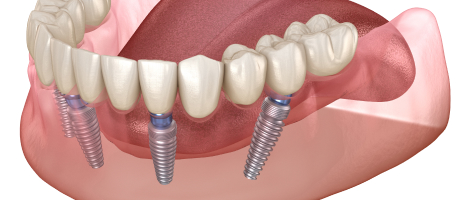Our Seattle Oral Surgeon Can Restore Your Smile with Dental Implants
Implant dentistry has transformed the landscape of tooth replacement, offering a permanent solution that looks, feels, and functions like natural teeth. At Maring Surgical, our oral surgeon specializes in providing top-tier dental implant services in Seattle that restore not just your smile, but your confidence and quality of life.
Don’t let missing teeth hold you back any longer. Contact our Seattle oral surgeon at 206-343-7500 to start your journey toward a complete, confident smile with dental implants. Maring Surgical is proud to serve patients from the nearby communities of Seattle, Medina, Bellevue, Kirkland, and Mercer Island.
What Are Dental Implants?
Dental implants are artificial tooth roots surgically placed into the jawbone to support replacement teeth. Made from biocompatible materials like titanium, these implants fuse with your bone over time, creating a strong foundation for crowns, bridges, or dentures. This innovative approach to tooth replacement offers unparalleled stability and longevity compared to traditional methods.
The Maring Surgical Advantage
Many patients require preparatory treatments before implant placement. These might include tooth extractions with bone grafting to build up jaw density and soft tissue treatment, including gum grafting to ensure a healthy foundation. At Maring Surgical, all of these treatments can be performed on-site since we have both an oral surgeon and periodontist in-house.
This integrated approach offers several benefits:
- Streamlined treatment process with fewer appointments
- Consistent care from a team familiar with your case
- Seamless communication between specialists
Our ability to offer this full spectrum of care in one location sets us apart in the Seattle area. It ensures that the surgical stages of your implant treatment are performed with the highest level of expertise and coordination, leading to optimal outcomes and a smoother patient experience.
The Benefits of Choosing Dental Implants
Patients can experience many benefits from dental implants, including:
- Natural look and feel
- Improved speech and eating ability
- Long-lasting results
- Preservation of jawbone health
- Enhanced oral hygiene
- Boost in self-confidence
Ready to discover how dental implants can change your life? Contact our Seattle oral surgeon and implant specialist today at 206-343-7500 to schedule your first appointment!
Types of Dental Implants

Single-Tooth Implants
Single-tooth dental implants replace individual missing teeth. A titanium post is surgically placed in the jawbone, topped with an abutment and a custom-made crown that matches your natural teeth.

All-on-4® Implants
Our oral surgeon specializes in All-on-4 dental implants, an innovative technique that uses just four implants to support a full arch of teeth. This method is ideal for patients missing multiple teeth or those transitioning from dentures. All-on-4 implants often allow for immediate loading, meaning you can receive your new teeth the same day as your dental implant surgery.

Implant-Supported Bridges
Implant-supported bridges use dental implants as anchors instead of relying on neighboring teeth. They’re an excellent option for replacing three or more adjacent missing teeth, providing superior stability and preserving the health of surrounding natural teeth.

Implant-Retained Dentures
For those needing full arch replacement, implant-retained dentures offer a more secure alternative to traditional dentures. These dentures snap onto implants, dramatically improving stability and chewing ability while preventing bone loss.
The Dental Implant Process at Maring Surgical & Dental Implant Center
1. Treatment Planning
It begins with a comprehensive consultation where our Seattle oral surgeon will assess your oral health, discuss your goals, and create a personalized treatment plan. Using our advanced imaging technology, we’ll map out the precise locations for your implants to ensure optimal results.
2. Dental Implant Placement
The implant placement itself is a surgical procedure performed under local anesthesia, ensuring your comfort throughout. Sedation dentistry methods are also available for patients undergoing longer, more complex implant procedures and patients with dental anxiety or special needs. At Maring Surgical, your safety is our top priority, and our staff is trained in assisting with IV sedation.
Following the placement, there’s a three to six-month healing period known as osseointegration, where the implant fuses with your jawbone. This creates a stable foundation for your new teeth. You should be able to wear temporary dentures and eat a soft diet during this time.
3. Final Restoration
After the implant has bonded to the jawbone, the second phase begins. You will return to your general dental office to have the final restoration placed. The entire implant process usually takes six to eight months. Most patients experience minimal disruption in their daily lives.

Maintaining Your New Smile After Dental Implant Placement
After your dental implant procedure, proper care is essential for long-term success. Our team at Maring Surgical will provide you with detailed aftercare instructions, including:
- Oral hygiene practices
- Dietary recommendations
- Follow-up appointment schedule
- Signs to watch for during healing
With proper dental implant care, your dental implants can last a lifetime, making them a cost-effective solution in the long run. If you have any questions, contact our downtown Seattle dental practice at 206-343-7500 .
Dental Implants vs. Traditional Tooth Replacement Options
While traditional options like bridges and dentures have their place, dental implants offer distinct advantages. Implants can last a lifetime with proper care, whereas traditional options may need replacement every five to 10 years. Unlike dentures or bridges, implants actively preserve jawbone health by stimulating the bone, preventing the bone loss often associated with missing teeth.
Stability is another key difference. Dental implants are fixed in place, providing a secure foundation that won’t slip or shift during eating or speaking. This stability allows for easier maintenance and cleaning compared to removable options. Perhaps most importantly, dental implants most closely mimic the look, feel, and function of natural teeth. This natural feeling not only enhances comfort but also boosts confidence, allowing you to smile, speak, and eat without worry.
Am I a Candidate for Dental Implants?
Most adults with good overall health are candidates for dental implants. However, factors such as bone density, gum health, and certain medical conditions can affect eligibility. At Maring Surgical, we perform thorough evaluations to determine if implants are right for you. In cases where bone density is insufficient, we offer advanced bone grafting procedures to prepare your jaw for implant placement.
Discover if dental implants in Seattle are right for you by calling 206-343-7500 to schedule a consultation with our dental team.
Financing Your Dental Implant Treatment
We understand that dental implants represent a significant investment in your oral health. That’s why Maring Surgical offers flexible financing through CareCredit to help make this life-changing treatment accessible. Our team will work with you to explore payment plans and insurance coverage, ensuring that financial concerns don’t stand in the way of your new smile.









